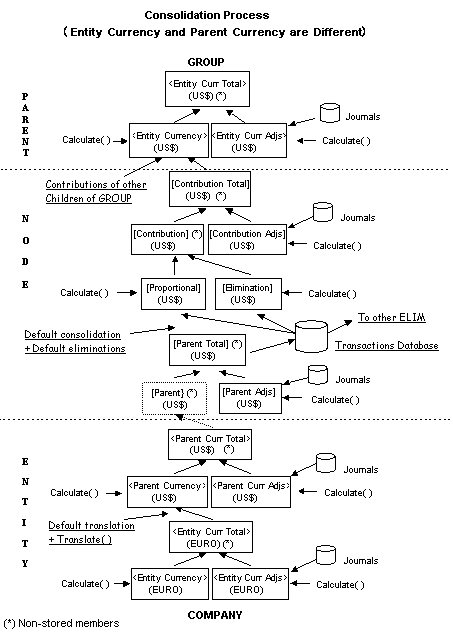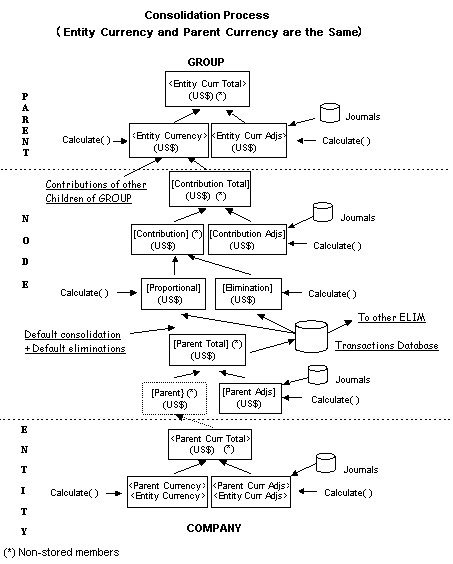Calculation Rules with Consolidation Commands
When a user selects one of the Consolidate commands, Oracle Hyperion Financial Management runs the Calculation rule for several of the Value dimensions that intersect each previously unconsolidated child entity. After executing for the children, Financial Management runs the rule for the intersection of the parent entity and the member of the Value dimension for the parent’s default currency.
-
The rule is run for the intersection of the child entity and the Value member that stores the child entity’s default currency (Entity Currency).
-
If the child entity’s AllowAdjs attribute is set to Y, the rule is run for the intersection of the child entity and the Value member that stores adjustments in the child entity’s default currency (Entity Curr Adjs).
-
If the child’s currency differs from the parent’s currency, the rule is run for the intersection of the child entity and the Value member that stores amounts translated to the parent’s home currency (Parent Currency).
-
If a child’s currency differs from the parent’s currency and the rules file contains a Translation rule, Financial Management executes the Translation rule before step 3.
-
If the child’s currency differs from the parent’s currency, and the child entity’s AllowAdjs attribute is set to Y, the rule is run for the intersection of the child entity and the Value member that stores adjustments translated to the parent’s home currency (Parent Curr Adjs).
-
If the parent entity’s AllowAdjFromChildren attribute is set to Y, the Logic rule is run for the intersection of the child entity and the Parent Adjs value.
-
The rule is run for the intersection of the child entity and the Proportion value.
-
The rule is run for the intersection of the child entity and the Elimination value.
-
If the parent entity’s AllowAdjFromChildren attribute is set to Y, the rule is run for the intersection of the child entity and the Contribution Adjs value.
-
For each additional child entity that contains previously unconsolidated data, repeat steps 1 through 9.
-
The rule is run for the intersection of the parent entity and the Value member that stores the parent entity’s default currency.
Example
For example, a parent entity named UnitedStates has children named EastUS and WestUS. The children have the AllowAdjs attribute enabled. The UnitedStates entity has the AllowAdjs and the AllowAdjFromChildren attributes enabled. All three entities share a default currency of USD.
If you change data for EastUS and WestUS and consolidate UnitedStates, Financial Management runs the rule for each of these intersections of the Entity and Value dimensions:
-
EastUS and Entity Currency.
-
EastUS and Entity Currency Adjs. (EastUS’s AllowAdjs attribute has been set to Y.)
-
EastUS and Parent.
-
EastUS and Parent Adjs. (UnitedStates’ AllowAdjFromChildren attribute has been set to Y.)
-
EastUS and Proportion.
-
EastUS and Elimination.
-
EastUS and Contribution Adjs. (UnitedStates’ AllowAdjFromChildren attribute has been set to Y.)
-
WestUS and Entity Currency.
-
WestUS and Entity Currency Adjs. (WestUS’s AllowAdjs attribute has been set to Y.)
-
WestUS and Parent.
-
WestUS and Parent Adjs. (UnitedStates’ AllowAdjFromChildren attribute has been set to Y.)
-
WestUS and Proportion.
-
WestUS and Elimination.
-
WestUS and Contribution Adjs. (UnitedStates’ AllowAdjFromChildren attribute has been set to Y.)
-
UnitedStates and Entity Currency.
Following are examples of the consolidation process.
The first example shows the process when the entity currency and the parent currency are different.

The following example shows the process when the entity currency and the parent currency are the same.
